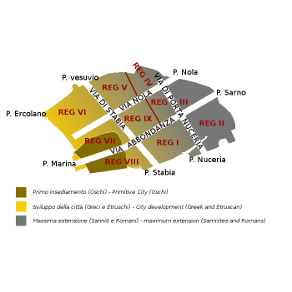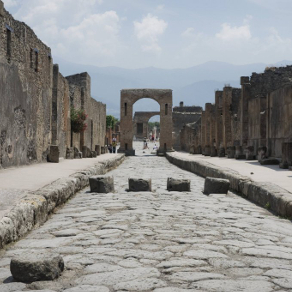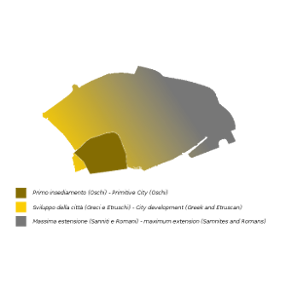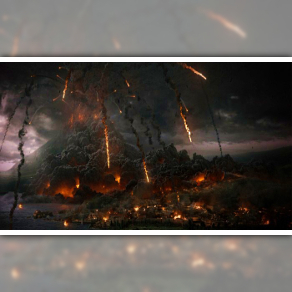The Ancient Pompeii
Pompeii is located at the southern end of an ancient lava flow on Vesuvius, with an elevation of 40 meters above sea level and next to River Sarno, an excellent water supply considering that there are no springs in the area.

At the time of Osci the first town centre, that was mainly rural, corresponds with the present Forum area. The renovation and the development began thanks to the Greeks (and for a period thanks to the Etruscan too) who started to construct the Triangular Forum and the Temple of Apollo, extending the area.
The Samnites arrival represented the moment of biggest expansion. In that period the urban centre was 66 hectares and it was delimited by imposing tuff walls, the perimeter was 3220 meters and it had 6 gates (Porta Marina, P. Herculaneum, P. Vesuvius, P. Nola, P. Sarno, P. Nuceria, P. Stabiae; the existence of an eighth gate, Porta Capua, is uncertain); it was divided in nine regions by two longitudinal arterial roads (decumanus maximus, Via Nola and Via dell’Abbondanza) and two diagonal arterial roads (cardo maximus, Via di Stabia and Via di Porta Nocera) that corresponded with the main roads because they connected the most important monuments, each region corresponded with a district (a block, insulae) where local festivals, political agenda and manufacturing and commercial business took place.
This city planning follows a model proposed by the Greek architect Hippodamus of Miletus, even if it couldn’t be adopted perfectly because it was lacking of the rigid street crossing at right angles disposition and the blocks didn’t have the same dimensions.
This city planning lasted for 350 years followed by the continuous renovation and decoration.

With the Roman arrival the city lived a period of ongoing maintenance and updating: high pavements were built along the roads with big bulging stones because sewers didn’t exist; pedestrian area were realized (as the Forum) and other areas that had regulated access (such as the Amphitheatre); public toilets (thermal baths) were increased and located in the three most required places; hotels (hospitia) and animal storages (stabula) were built next to the city gates and to the Forum; along the main roads there were many taverns (cauponae) and thermopolium.
Each private building was equipped with a tank (impluvium) put outside to pick up rainwater that was saved in a cistern.
The Romans built a deviation of the Augustan aqueduct: the water flowed to the Castellum Aquae and it was possible to distribute it to the thermal baths, public fountains and to the richest homes by water pipe system. The drainage system was tiny and it only served the public latrine, so each home was equipped with a well.
When the eruption started, Pompeii had approximately 20.000 inhabitants: most of them were merchants, freedman and slaves from Campania, Greece and Asia; there were few patrician families with Samnite origins or Roman immigrates.
Soon the merchant class began to spread out into the city to the point the entire homes became shops or factories; the people who got rich modified their Samnite houses, frequently uniting two or more accommodations.
During the Augustan period when the city needed no defence, new buildings began to be built beyond the walls.
Before the Vesuvius eruption, there were three public administration organs in Pompeii: the popular assembly that was the pòpulus; the council of decurions, called the òrdo decuriònum; and four administrators: two duòviri iùre dicùndo and two ediles.
The pòpulus, composed of free male citizens, elected the magistrates and public priests, and ratified the deliberations of the Council of decurions.
The council of decurions was composed by 100 members who had to enjoy a good reputation, practice an honourable profession, and be rich enough to pay their own expenses of entertaining and ceremonial; this council held powers of deliberation and control over all sectors of public life.
The higher magistrates, the duòviri iùre dicùndo, staying in power for 5 years, administered justice, checked the fiscal and administrative situation of the city and verified if the individual decurions had maintained the requisite conditions for office.
The aediles, who were lower in rank than those already mentioned, were elected every year and had executive power: they saw to the maintenance of public buildings and roads, controlled the markets and the municipal police service, and organized public and private festivities.
All the news regarding the public life such as elections, shows, economic proclamations were promoted with specific signs and illustrations made by expert "scriptores" on the buildings wall. Graffiti was very common (made by workers, lovers, students, supporters, wayfarers, and even scoundrels) and it is a good proof of the problems and experiences of everyday life in that period.






